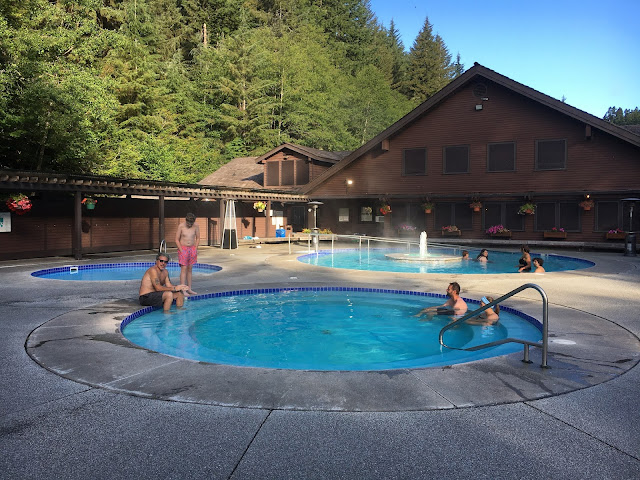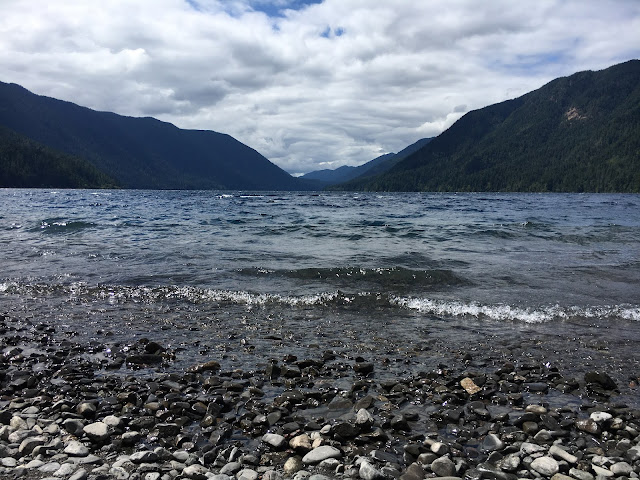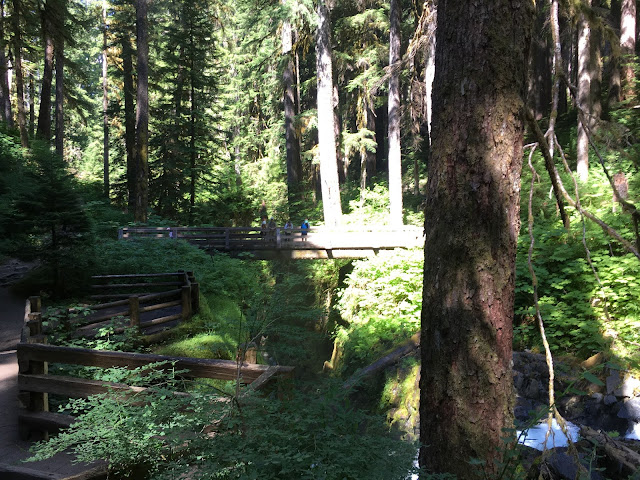The sobering truth of our beautiful National Park vacations is that we are trying to capture a "snapshot" in time. Often I feel as if we are in a race with Climate Change. When visiting the Grand Canyon in 2017, fires were blazing in the north; when visiting Yosemite in 2018, we drove through miles of scorched and charred forest from a previous fire.
As we made this journey to the Pacific Northwest, there were fires blazing in Washington and Oregon, and Sol Duc Valley/Seattle had just experienced its hottest day on record with temperatures up to 118 degrees on June 28, 2021.
On the last day of our great Olympic National Park adventure, we drove to Port Angeles for lunch and then made the 18-mile, half-hour trek to Hurricane Ridge. Did I mention the road snakes up the ridge to an elevation of 5,242 feet above sea level? Some reviewers claim it is not a scary drive at all, but if you are scared of heights like me, the winding road with no guardrails or barriers can make for a white-knuckled, heart-pounding experience. My husband drove on the way up, and I requested to take the wheel on the way down, vowing to not look at anything other than the lines in the road to very carefully maneuver our drive to the bottom. The brakes of our rental car squeaked the whole way down!!
While we were in Port Angles, we quickly discovered that the bustling city was full of "closed" restaurants. Not unlike many places in the country, most restaurants in the area had a shortage of cooks and waitstaff, which meant that they had limited hours of service. After walking a few blocks, we finally settled on eating at a pizza restaurant called The Roosevelt, (which was quite fitting since President Roosevelt founded the park). They were thankfully open for business, so we could enjoy a full meal before making the trip to Hurricane Ridge.
According to my Olympic National Park travel book, Hurricane Ridge is "the jewel of the park, which rises one mile high" and is "one of the most scenic areas, offering spectacular panoramic views of the Strait of Juan de Fuca, the peaks of the Olympic Mountains, the Canadian Cascades, and alpine wildflower meadows." While I am not a huge fan of mountains, ridges, cliffs, etc., I knew that a trip to Olympic National Park would not be complete without actually viewing the mountains themselves for which the park is named. Even more, the ridge showcases glacier-covered peaks, such as the Blue Glacier, Lillian Glacier, and Anderson Glacier. The Blue Glacier is the largest in the Olympic Mountains at "2.6 miles long" and it is so large that it is "equal to over 20 trillion ice cubes."
According to the Olympic National Park website, "The glaciers of the Olympic Mountains and the neighboring Cascades helped sculpt the wild, beautiful landscape that attracts millions of visitors to Olympic, North Cascades and Mount Rainier National Parks. They comprise the most glaciated area of the United States outside of Alaska" and "their meltwater combines with annual snowpack to feed rivers, forests, and lowland communities [including nurturing cold-water-loving fish like salmon and bull trout]."
Seeing the view of the Olympic Mountains, the Canadian Cascades and the glaciers was a trip favorite. In fact, while Lewie was impressed by the Hoh Rain Forest, Rialto Beach, Marymere Falls, and Sol Duc Falls, he was astounded by the view at Hurricane Ridge. In fact, he loved it so much that he asked me for a keychain and postcard at the ranger station/gift shop. (That's a big deal for him.)
While I was in complete awe of the beauty myself (once my legs stopped shaking), I couldn't help but worry this may be our only time viewing real-life glaciers. Pictures of the glaciers taken as far back as 1899, 1905, and 1936 show large, robust ice sheets covering most of the mountains. Today, most are barely visible, and some have disappeared. For example, "On Mount Anderson, its south-facing Anderson Glacier receded to less than 10% of its former size between 1927 and 2009, and was essentially gone by 2015!" You can view pictures of these glaciers here.
As we left, a deeper worry haunted me. What would become of the Hoh Rainforest, Marymere Falls, Sol Duc Falls, and all the incredible wildlife if there were no more glacier melt to feed the rivers and forests? A sense of dread took over me that still lingers...
As we said goodbye to the gorgeous views "of the most glaciated area of the United States outside of Alaska," we headed to our next trip destination: Seattle. Getting to Seattle would take more than a car. Since we needed to cross the Puget Sound, our GPS navigated us right to the town of Kingston where we would take a ferry over to Edmonds. (Fun Fact: Washington State is home to the largest ferry fleet in the U.S.)
 |
| The line of cars in Kingston waiting for the ferry. |
It was Little Lewie's lucky day because if he wasn't already awestruck by Hurricane Ridge, he was over-the-moon about getting to go on a ferry. (This kid loves them.) The town of Kingston was so cute, and while there wasn't enough time to explore, we did have time to order dessert at J'aime Les Crepes, so we could bring it back to our car as we waited to drive onto the ferry. After the ferry, it would be only 33 more minutes to our next hotel in Kirkland (outside of Seattle)--a hotel that would probably not have a mouse but would have internet service!
























































































